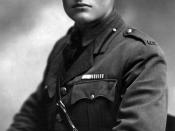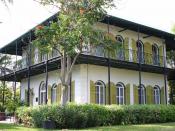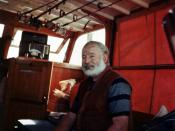Ernest Hemingway's opening paragraph in "Hills Like White Elephants" immediately pojects his readers into a landscape that is barren and uncomfortable. It is a scene so simple, yet so the vivid, that the reader physically senses the burning of the sun and the stillness of the day, interrupted only by the pesky flies and the woman from the bar. It is a scene symbolic of the lives, the future, and the relentless indecision that confronts the American and the girl, Jig.
The story takes place in Spain, at an apparently small railway station above the valley of the Ebro River, somewhere between Barcelona and Madrid. The time is probably the early or mid-1920's, when the post-war "lost generation" was in exile. It is fitting that Hemingway should choose, as a setting for his story a junction--that place where lines, roads, and railways come together or cross.
The American and the girl are at a junction of their own, a point at which they must decide which route to take.
And herein lies the conflict. Abortion is the issue. A decision rests somewhere between their two trains of thought, just as "the station was between two lines of rails in the sun." The American wants to leave this "station," this stopover in their voyage, and continue their nomadic wanderings without an extra passenger. He vehemently declares, "I don't want anybody but you. I don't want anyone else." He knows, at first, what he wants Jig to do, and gently attempts to persuade her: "I'll go with you and I'll stay with you all the time. They just let the air in and then it's all perfectly nature." The girl, however, is plagued with uncertainty as relentless as the scorching sun. There is "no shade and no tress," no relief...


